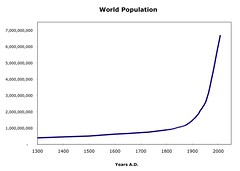An enterprise starts with the hope of a return on its investment. For a start-up, this is often envisioned on a spreadsheet, with the initial revenues being smaller than the initial expenses creating losses; however, the revenues increasing by some percentage and over time they outpace expenses to generate an attractive return on investment (ROI). While that is the typical story on paper; it's not reflected in the reality around us.
The World Population graph seems to show a linear growth like the one described in the above plan with some event happening in the late 1800's to suddenly make it change. Any idea what that historic event might have been?
If you haven't read the paper folding post, this may make a more sense if you do that. The graph shows natural, exponential growth. If we would change the time scale to end a century earlier, the curve would look the same, only the historic event would now appear to be in the late 1700's. End another century earlier, and the momentous event still moves back with the new scaling.
There was no event that changed the World population growth rate. Population growth is an example of growth from feedback and this graph is what that curve will always looks like. Small victories in the beginning, remaining small for far longer than our linear minds can imagine, then accumulating faster than linear thinking can grasp.
The two mistakes we can make are to believe the smaller growth rate is failure or to not accept the higher growth rate as success and invest in necessary infrastructure to keep the feedback going. It takes a faith that the returns will really happen to avoid either downfall. Of course this growth doesn't go on forever. There are always limits to growth; however, some are just in our linear minds.
During the Beatles's era, Maharishi Mahesh Yogi, who may have been the subject of their song Fool on the Hill, challenged his followers with the claim that if the square root of 1% of a population practices Transcendental Meditation (TM), crime in the area would decrease. In 1993, TM followers came to Washington DC during a record heat wave (which correlates to increased crime) to create such a critical number. Crime decreased for the period of the experiment. After its conclusion, it increased again.
This is not unique to TM. The story has been repeated in countless endeavors where fools have believed in continuing to repeat something powerful and gentle until the feedback effects can finally be observed; or until their return on investment is finally realized. We live in a faithful (systematic) universe; just not a linear one.
Image credit: mattlemmon

![Reblog this post [with Zemanta]](http://img.zemanta.com/reblog_e.png?x-id=9ff68a50-a67e-4b57-9204-4eb49a40451d)
This comment has been removed by a blog administrator.
ReplyDelete